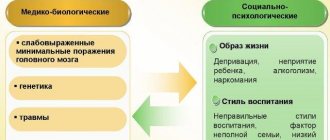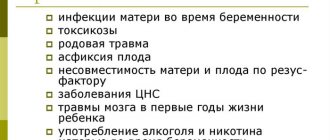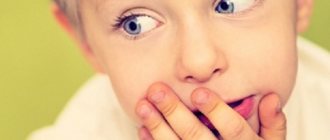Last name, first name _______ Date of birth ______ General physical development _____ Health status _____ Family composition _____
This is also important to know: How to write a letter of guarantee for employment: sample
Entered preschool educational institution____
She has been attending kindergarten since August 20__. I quickly adapted to kindergarten.
A child from a complete family. Relationships with parents are built on a warm, friendly basis. In a family, the child communicates most with his mother. At home he prefers to draw, play checkers, draw, and lego. He readily responds to his mother’s offers to help with cleaning the house. Places toys independently.
Somatic health. She rarely gets sick, has a good appetite, falls asleep quickly, and has a restful sleep.
Social skills are age appropriate. The child can independently use toiletries, wash his face, wash his hands, comb his hair, can dress, undress, put on his shoes, and use a spoon independently. The boy is aware of his physical capabilities. Aware of himself in time and space.
Features of gaming activity: the child prefers subject-based procedural and active games, participates in role-playing games, performing different roles in them. He loves to play outdoor games and cars with other children. He enjoys playing with Legos and loves listening to fairy tales.
The main difficulties noted in communication: The child has developed a friendly attitude towards children and has developed a desire to cooperate with them. Among the guys in the group there is a constant circle of friends with common interests. Willingly makes contact with adults.
Features of individual cognitive processes: The child is distinguished by a high level of development of attention, auditory and visual memory, and imagination. Visual-figurative and elements of logical thinking are quite well developed.
Speech development: The child has good speech development. Pronounces all phonemes, knows how to identify phonemes in a word. The child has a large vocabulary. Builds sentences correctly. Monologue speech predominates: correctly constructs oral messages and reasoning about ways to perform actions.
The main difficulties noted in training: The child easily masters the program; the pace of work during classes is uniform. Shows interest in activities. He enjoys his work and feels confident there. He reacts negatively to criticism, may become offended and stop completing the task. Loves praise and approval, which he tries to earn. The child's level of moral development is normal. The boy knows what is good and what is bad.
Loves to be in kindergarten. The cognitive type of communication with the teacher predominates. He understands that in kindergarten he is taught to read, draw, speak English, and dance. This is precisely why he loves his teacher.
Character traits. The boy is sociable, affectionate, friendly, touchy.
Psychologist of preschool educational institution No.___: __________________
Head of preschool institution No.___: ___________________
Psychological and pedagogical characteristics for a preschool educational institution graduate for admission to school
1st option
Full name, date of birth, address ______________
Pupils of preschool educational institution No. _______, group No. ________
Date of admission to preschool educational institution ______________
1. Information about the family: mother’s full name, year of birth, place of work; Father's full name, year of birth, place of work; conditions of education. The family is complete, incomplete, conditions are satisfactory or not, indicate the reasons for unsatisfactory conditions.
2. The stock of information about the environment ______________
3. Characteristics of cognitive processes: attention (ratio of voluntary and involuntary, concentration); memory; thinking (features of analysis, synthesis, generalization, classification, establishment of cause-and-effect relationships); sensory development (properties of objects, time orientation); speech (dictionary, grammatical structure of speech, sound pronunciation); sound-letter analysis.
4. Development of elementary mathematical concepts
5. Features of motor development (gross and fine motor skills, leading hand, presence of motor disinhibition, state of constructive and graphic skills).
6. Formation of motivation for educational activities
7. Emotional-volitional sphere and individual psychological characteristics of the child.
8. Recommendations ______________
2nd option
1. General information about the child: full name, date of birth, home address, since when he has been attending the preschool educational institution.
2. Family characteristics: parents’ full names, year of birth, place of work; family composition: complete, single-parent, large, presence of brothers and sisters; who is raising the child (mother, father, grandmother, others); whether sufficient attention is paid in the family to the upbringing and education of the child.
3. Typological features: active, mobile, sluggish, inert, slow; excitable, unbalanced, calm, balanced, inhibited, whiny; speed of reaction to verbal stimuli, switchability; the prevailing mood is cheerful, depressed, without any special shade. Do you experience sudden mood swings throughout the day? whether he persists in the face of difficulties or retreats in the face of them; whether he asks for help and uses it.
This is also important to know:
Characteristics of a student undergoing internship
4. Characteristic features: sociability, isolation (easily makes contact, perceives the situation correctly, understands its meaning, behaves adequately, contact and communication are difficult, understanding and responding to the situation is not always or not entirely adequate, does not make contact well, has difficulty in communication, understanding the situation); attitude towards comrades (friendliness, negativism, kindness, rudeness, etc.); attitude towards leadership (desire for primacy, whether others recognize him as a leader, whether he shows organizational skills and initiative); attitude towards adults; attitude towards assignments, rewards, reprimands; what types of activities does he prefer; activity of verbal communication (corresponds to age, increased, decreased, isolation noted, negative attitude towards verbal communication); behavior (organized, sometimes does not regulate one’s behavior, constant external control is required).
5. Psychological characteristics: auditory memorization, visual memorization, tactile memorization (memorizes quickly or slowly, with difficulty, transition to long-term memory, RAM capacity: sufficient, limited, low); stability of attention (capable of long-term concentration or easily distracted); nature of distraction (distracted by stimuli, in the absence of external stimuli); switchability of attention (easy, fast, slow, difficult); distribution of attention (sufficient, difficult); general level of attention development (age-appropriate, low, unformed).
6. Level of development of mental activity: the ability to compare, classify, generalize, the ability to identify an essential feature of objects and phenomena; the ability to use techniques for memorization (mediation, grouping, associations).
7. Development of sensory functions: the state of the analyzers, the presence of generalizing ideas about shape, size, color - the concept of relativity - corresponds to age, unformed, impaired.
8. Development of imagination: brightness, liveliness, richness of imagination, ability to operate with images, in what types of activities it manifests itself (music, arts, mathematics, physical education, speech, design, etc.), age-appropriate, excessive, weakness of imagination processes.
9. Verbal part: understanding stories with hidden meanings; paired analogies; plot storytelling - nominative and communicative functions of speech; ability to maintain dialogue; speech activity is adequate to the situation and age, excessive, difficulties in initiating a speech utterance, emotional inadequacy, problems with expanded speech, difficulties in sound pronunciation, the presence of stuttering, echolalia, speech cliches, etc.
10. Performance in the classroom: active, interested, indifferent attitude; concentrated or often distracted during classes; quickly or slowly starts working; pace of work: fast, medium, slow; reasons for the slow pace of work: thinking, careful execution, decreased mental activity (lethargy, lethargy, distractibility, etc.); fatigue manifests itself in a slowdown in pace, deterioration in quality, or complete cessation of work; subjective and objective I admit! fatigue (complaints of fatigue, headache, lethargy, drowsiness, distractibility, etc.); decline in performance (in the middle of the lesson, at the end of the lesson); ability to follow instructions, ability to retain instructions for duration.
11. Arbitrariness of activity: holds the goal of the activity, outlines its plan, selects adequate means, checks the result, brings the work started to completion; often gets distracted during activities, overcomes difficulties only with psychological support, needs frequent encouragement; the activity is chaotic, ill-conceived, individual conditions of the task are lost, the result is not checked, the activity is interrupted due to difficulties, assistance is ineffective.
12. Work carried out with the child: whether developmental, correctional, accompanying work was carried out for how long, type (on the formation of spatial concepts, development of cognitive processes, emotional education, etc.); recommendations for further work; results, success, skill formation (by age, with difficulty, delayed); work with parents, family (parental attitude, success, systematicity, etc.).
* * *
And in conclusion, we bring to your attention “Portrait of a kindergarten graduate,” which can serve as a guide in determining the normal development of a child upon graduation from kindergarten and drawing up a psychological and pedagogical profile.
Organizational aspects
The document is prepared with the participation of a psychologist, speech therapist and teacher. A ready-made description of a kindergarten student is provided for:
Free legal consultation
We will answer your question in 5 minutes!
Free legal consultation We will answer your question in 5 minutes!
Call: 8 800 511-39-66
Ask a Question
- Admission to school.
- Solutions to legal issues.
- Consultations with a psychiatrist.
- Commissions for transfer to a speech therapy group or specialized educational institution.
- Children with disabilities who attend kindergarten.
- Guardianship and trusteeship authorities.
This is also important to know:
How to write a letter of request correctly
The pedagogical characteristics of a preschool educational institution student is an official document that is invalid without the signature of all persons filling out the form. The seal and signature of the head of the institution is also required.
“Characteristics of a preschooler with developmental disabilities (sample)”
Characteristics (sample)
Ivanov Ivan Ivanovich, born ____________, visits the structural unit implementing the educational program of preschool education_____________________________________________ from June 25, 2022.
Adaptation upon admission to the preschool department is conditionally favorable.
He does not visit the structural unit regularly and is often sick. I did not study under an individual program.
Currently, he is a pupil of the middle group and is studying in the general education program of preschool education “From birth to school”, edited by N.E. Veraksa.
Ivan lives in a complete family, surrounded by attention and care from his parents. Has a younger sister. Family relationships are positive. Social conditions are good. Both parents are involved in raising the child. Parents are interested in the upbringing and development of the child and maintain a daily routine.
Ivan shows little interest in classes, but there is motivation to learn. Understanding speech at the everyday level. Begins to show interest when viewing illustrations and reading nursery rhymes and dramatizations with toys. The boy, at the request of an adult, finds the necessary objects himself or with the help (points with his hand or picks them up), performs play actions (“Feed the doll”, “Put the doll in the crib”, etc.). There is no phrasal speech, it consists of individual onomatopoeias and several common words, such as: “Am - am”, “Bi-bi”, “Go”, “Give”, “Na”, “No”, “Bah”, etc. Speech inexpressive, indistinct, illegible, incomprehensible to others; medium-modulated voice; breathing is free, shallow. Vocabulary is below the age norm of development. Passive and active vocabularies are characterized by poverty and are limited to everyday topics. The grammatical structure of speech is not formed.
Attention is unstable, distracted, the rate of work capacity is low, fatigue is easy. Perception - correctly shows primary colors, but gets confused in shades. Knows simple geometric shapes, correctly correlates them with the model, puts together large cut pictures from 4 parts. Visual memory predominates; The memory capacity is small, memorization is short-term. Low level of thinking development. Does not build cause-and-effect relationships. Thinking of a specific situational nature.
The level of assimilation of educational material on familiarization with the outside world is formed at a low level. The child shows various objects that surround him indoors, outdoors, on the site and knows their purpose. Knows domestic and wild animals, fruits, vegetables, transport, household appliances, does not use generalizing words.
Mathematical understanding is below average, with some difficulties. The child has difficulty showing geometric shapes. Knows basic colors. There are some difficulties in spatial representations: determining movement from right to left, back and forth, behind and under.
Ivan performs the basic movements correctly. The child's coordination of movements is not impaired. He enjoys getting involved and mastering new movements. Actively and interestedly participates in outdoor games, but does not always keep up with the general pace. The sense of rhythm is not impaired.
In his productive activities, Ivan receives help from a teacher, which he willingly accepts. The child holds the brush and pencil incorrectly and has some difficulty relating objects and their parts by size and location relative to each other. At the end of the work, he tidies up the place.
He loves to design, plans the creation of a building in advance, and creates it according to a model. Uses building material of different sizes and different materials. Help from an adult is readily accepted.
Ivan is dominated by an unstable emotional background of mood. He is selective in relationships with peers, plays in a group of 1-2 children.
Danil is open, friendly, emotional, very inquisitive, easily excitable, impulsive, and not inclined to offend others.
Ivan is prone to auto-aggressive behavior (injures himself in the forearm area). The reason for this behavior, according to the observations of the group’s teachers, is the child’s inability to verbally express his emotions.
Sanitary and hygienic standards have been formed.
Head of the joint venture
Description of other character traits of the child
The document drawn up by the teacher, describing the level and degree of personal development, must indicate the child’s performance, reaction to comments and demands, ability to manage his behavior, character traits (modest, quiet, impulsive, etc.). The description of the personality of a preschooler should also reflect the state of psychophysical processes: attention (stable or not), ability to concentrate, switchability, perception of phenomena (appropriate or not for age), the child’s time representations, development of memory and verbal-logical thinking. The characteristics of the child in the preschool educational institution from the teacher must be dated. The teacher's signature is placed on the last page. The document is endorsed by the head of the preschool educational institution.
Characteristics of a child with mental retardation and developmental disabilities of level 1
Characteristics of a pupil with mental retardation and developmental disabilities
preparatory group MBDOU ______________________ year of birth, resident
by the address: ______________________________
___________________ has been attending kindergarten since ____________ to this day.
Childhood disabled boy - ________________________________ (if any)
The adaptation period was difficult. The child did not understand spoken language and self-care skills were not developed.
Height and weight correspond to the lower age limit. Impaired mental function.
The family is complete, monolingual, with many children, the child has a stepfather
Hearing and vision are normal. Suffering from ________ (enuresis).
The development of speech motor skills, as well as general motor skills, is slow.
Perception
: generalization of perception is impaired, the scope of perception is narrow, it is characterized by a slow pace - it takes more time to perceive a picture or what is heard, constant compulsion is required;
difficulty perceiving space and time,
sees colors poorly; It is especially difficult to distinguish shades of color
Thinking:
thought processes are slow and inert;
abstract thinking does not develop at all, at the level of concrete concepts.
MEMORY:
remember external, sometimes random, visually perceived signs better; characterized by episodic forgetfulness, which is associated with overwork of the nervous system
ATTENTION
: characterized by low stability, distribution difficulties, slow switchability.
SPEECH:
the anatomical state of the organs of articulation without anomalies. The volume and accuracy of movements performed suffers. Speech motor skills are not sufficiently developed.
All aspects of speech suffer - phonetic, lexical, grammatical, semantic.
The child speaks a few words, mainly using gestures and onomatopoeia.
After speech therapy sessions, his understanding of speech has expanded and he can repeat simple words syllable by syllable.
Active speech
absent
Sound side of speech
Sound pronunciation: repeats individual sounds, syllables, simple words syllable by syllable
Vocabulary is poor
The volume of the passive vocabulary is much larger than the active one.
Lagging behind peers in all types of productive activities: drawing, modeling, designing. The drawings are primitive and fragmentary; the shapes and proportions of objects are distorted.
Games
are of an elementary imitative nature, are replete with stereotypical actions, there is no creativity or intention in the game. The boy does not learn well the rules of the game and how to handle objects at the level of manipulation. Interest in objects and toys turns out to be short-lived, because... prompted by their appearance.
Lack of interest and curiosity, low popularity among children.
In activities, imitation, impulsive actions, and an inability to suppress immediate instincts are often observed. There is no independence, sense of purpose, or initiative. Negativism and stubbornness develop due to the unbearable demands. They manifest themselves in negative reactions to comments and reproach.
The child has not developed learning skills. A situation of success evokes positive emotions in a child. The reaction to comments is inadequate - he gets offended and turns away. Relationships with children and adults are restrained and unstable.
Conclusion:
ZPR, ONR level 1.
Recommendations: examination and diagnosis at the regional primary medical examination.
Teacher: _______________ Speech therapist: _________________
Manager: ____________________
Guidelines for compiling characteristics
When compiling a profile, it is necessary to provide information about the student as completely as possible. This document will be the basis for further work with the child by specialists. Incomplete information can greatly reduce positive qualities.
To compile the document, you can use the following recommendations:
- Social information about a minor. This paragraph should include all information about the child’s family. If possible, indicate family relationships. If there are diseases among relatives that may carry a genetic predisposition, this type of information is also indicated. Material assessment of the family in which the pupil lives.
- Peculiarities of pedagogical assessment of a student. This paragraph provides information on the student’s mastery of all the basics of everyday activities. The predisposition and skills of the minor in any particular direction are indicated. The degree of perception of information that the student receives during classes. Perseverance and ability to listen to the teacher.
- The play activity of the pupil also plays a role in drawing up the document, since the child, especially in the first years of life, shows most of his emotions in a playful form. At this point, you should describe how the child manifests himself in logic games. How friendly he can be in group games. The student’s desire to demonstrate leadership abilities.
Advice from experts for compiling a complete profile for a student:
- conduct observation of the pupil in his natural environment;
- conduct testing in various fields of activity, which will identify predisposition to a particular occupation;
- When drawing up a document, you should not indicate information without good reason. In this type of document, educators' assumptions cannot be used;
- through communication with the pupil’s parents and relatives, find out who is the priority for the child;
- Using psychological tests and conversations, identify the state of the atmosphere in the family circle and how it affects the student.
For each kindergarten teacher, a specific methodology is selected to study the general condition of the child.
The characteristics cannot be compiled only on simple observation; to reduce the likelihood of missing any important information, one should obtain an expert assessment from several specialists and combine it in the characteristics.
A correctly compiled description serves as a further basis for observation and work with a minor child.
Note! In many situations, general templates can be used to help educators draw up a document. However, such actions are considered erroneous and can hide the child’s individual characteristics and hinder further development in certain directions.
Didn't find the answer to your question? Find out how to solve exactly your problem - call right now: +7 (Moscow) +7 (812) 309-53-42 (St. Petersburg) It's fast and free!





